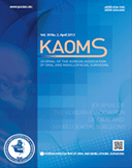Journal of the Korean Association of Oral and Maxillofacial Surgeons
- P-ISSN2234-7550
- E-ISSN2234-5930
- SCOPUS, KCI, ESCI
 ISSN : 2234-7550
ISSN : 2234-7550
Evaluation of two interforaminal implants and implant-assisted removable dentures on stress distribution: an in vitro study
Onur Geckili (Faculty of Dentistry, Istanbul University, Istanbul)
Altug Cilingir (Faculty of Dentistry, Trakya University, Edirne)
Ergun Bozdag (Istanbul Technical University, Istanbul, Turkey)
Hakan Bilhan (University Witten/Herdecke, Witten, Germany)
Abstract
Objectives: In mandibular edentulism, the treatment option with a two-interforaminal implant-retained bridge and a removable partial denture is rarely evaluated in literature. The aim of this in vitro study was to evaluate the stress distribution of this treatment option by comparing it with traditional treatment options with interforaminal implants in the edentulous mandible. Materials and Methods: Two interforaminal implants were placed in a formalin-fixed cadaver mandible, and overdentures with three different types of attachments were fabricated: (1) two ball attachments and an overdenture, (2) a Dolder bar and an overdenture, and (3) screw-retained two-implant inter-canine porcelain fused to a metal bridge and an implant-assisted removable denture (IARD) with precision attachments. Three biting conditions were generated for each denture type, and the strains were documented under vertical loading of 100 N. Results: The calculated strain values from measured strains in all measurement sites and loading conditions for the screw-retained two-implant inter-canine porcelain fused to a metal bridge and a cast framework partial denture with precision attachments situation were lower than in the other scenarios (P<0.05). Conclusion: Within the limitations of the present study, it can be concluded that an IARD may be a reasonable and valuable alternative to ball attachments or a bar in two interforaminal implants, especially when the patients prefer to be able to show their teeth even when they take out their removable dentures.
- keywords
- Implant, Strain gauge, Removable denture, Overdenture, Dental
- Downloaded
- Viewed
- 0KCI Citations
- 0WOS Citations